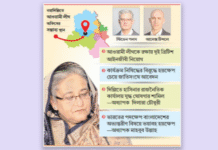
What a rise in sea-levels could mean for coastal cities such as Chittagong
The plying of boats in flooded roads is not new to Chittagong city. But the recent waterlogging in Chittagong perhaps broke all previous records, with water rising as high as five feet at places, and some of the residents, habituated with the problem, calling it unbearable.
In the last several years, the parts of the city prone to waterlogging were flooded due to rain and tidal surges. But the latest spell in the last few years is the worst.
While the residents of Chittagong have gotten used to two or three feet deep water during the rainy season, suddenly, the water rose as high as five feet.
Usually, the water surge from Chaktai canal keeps the areas inundated for around 10 to 12 days a month during monsoon, especially on the occasions of the full and new moon. The residents are habituated to that, but what happened recently is unexpected for many people.
I think what happened in Chittagong recently is, partly, the impact of this year’s La Niña and “king tides.” King tide is a non-scientific term people often use to describe exceptionally high tides. They are naturally occurring, predictable events.
Tides are the movement of water across Earth’s surface caused by the combined effects of the gravitational forces exerted by the moon, sun, and the rotation of earth which manifest in the local rise and fall of sea levels. The term “king tide” originated in Australia, New Zealand, and other Pacific nations to refer to an especially high tide that occurs only a few times per year.
When high tides and sea levels combine to exceptionally high water levels, coastal flooding can occur to the extent that salt water comes onto roadways and into landscaping or even buildings, sometimes causing substantial damage. When high water levels, combined with wave action, meet a natural or man-made barrier, like beaches, dunes, or seawalls, erosion often occurs.
King tides by themselves are not sufficient to cause inundation, but they do facilitate inundation when a significant wave event or high sea level event occurs at the same time. Several factors contribute to the total water level at the coast.
Astronomical, climatic, and meteorological fluctuations occur naturally, eg, daily tides, king tides, sea level fluctuations sometimes associated with La Niña, wave set-up, and storm surges. This year’s La Niña is particularly important as it is causing higher than normal tides at the coast.
King tides are not related to climate change — they are natural tide cycles — but they do provide a preview of what we could experience with higher future sea levels. Increases in global sea levels have been recorded (direct observations) for many years, and more recent observations have been collected by NASA satellites.
The steady rise in sea levels has been attributed to both a warming expansion of the oceans and contributions from melting glaciers and land-based ice sheets. Climate modeling combined with these direct observations suggest sea level rise will continue well into the future with significant implications for coastal communities.
During extreme high tide events, we can get an idea of what a permanent rise in the sea level might look like in the coastal communities like that of Chittagong in Bangladesh. Hence, the king tides provide a glimpse at what is expected to become the “new normal” over the next decades due to global sea level rise.
Md Rashed Chowdhury is the Principal Scientist of the ‘Pacific ENSO Applications Climate Center’, University of Hawaii Manoa, USA. Email: rashed.uh@gmail.com.









